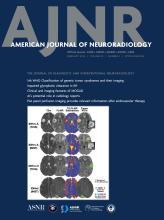Index by author
Rao, Dinesh
- FELLOWS' JOURNAL CLUBBrain Tumor ImagingOpen AccessNewly Recognized Genetic Tumor Syndromes of the CNS in the 5th WHO Classification: Imaging Overview with Genetic UpdatesAmit Agarwal, Girish Bathla, Neetu Soni, Amit Desai, Pranav Ajmera, Dinesh Rao, Vivek Gupta and Prasanna VibhuteAmerican Journal of Neuroradiology February 2024, 45 (2) 128-138; DOI: https://doi.org/10.3174/ajnr.A8039
In this review of the new 5th edition of the WHO classification, the authors focus on imaging and genetic characteristics of 8 new syndromes: Elongator protein complex-medulloblastoma syndrome, BRCA1-associated protein 1 tumor-predisposition syndrome, DICER1 syndrome, familial paraganglioma syndrome, melanoma-astrocytoma syndrome, Carney complex, Fanconi anemia, and familial retinoblastoma.
Raymond, Catalina
- EDITOR'S CHOICEBrain Tumor ImagingYou have accessQuantification of T2-FLAIR Mismatch in Nonenhancing Diffuse Gliomas Using Digital SubtractionNicholas S. Cho, Francesco Sanvito, Viên Lam Le, Sonoko Oshima, Ashley Teraishi, Jingwen Yao, Donatello Telesca, Catalina Raymond, Whitney B. Pope, Phioanh L. Nghiemphu, Albert Lai, Timothy F. Cloughesy, Noriko Salamon and Benjamin M. EllingsonAmerican Journal of Neuroradiology February 2024, 45 (2) 188-197; DOI: https://doi.org/10.3174/ajnr.A8094
The T2-FLAIR mismatch sign on MR imaging, usually determined by visual assessment, is a highly specific imaging biomarker of IDH-mutant astrocytomas. The authors of this study quantified the degree of T2-FLAIR mismatch in nonenhancing diffuse gliomas. Thresholds of ≥42% T2-FLAIR mismatch volume classified IDH-mutant astrocytoma with a specificity/sensitivity of 100%/19.6% (TCIA) and 100%/31.6% (institutional). They also found that grades 3–4 compared with grade 2 IDH-mutant astrocytomas (P<.05) had a higher percentage T2-FLAIR mismatch volume.
Riascos, Roy
- EditorialYou have accessStriking a Balance: Global Perspectives on Neuroradiology Workload and Quality of ServiceMax Wintermark, Kei Yamada, Tchoyoson Lim, Roy Riascos, Carlos Torres and Tarek YousryAmerican Journal of Neuroradiology February 2024, 45 (2) 127; DOI: https://doi.org/10.3174/ajnr.A8125
Risch, Franka
- FELLOWS' JOURNAL CLUBNeurointerventionYou have accessDiscrimination of Hemorrhage and Contrast Media in a Head Phantom on Photon-Counting Detector CT DataFranka Risch, Ansgar Berlis, Thomas Kroencke, Florian Schwarz and Christoph J. MaurerAmerican Journal of Neuroradiology February 2024, 45 (2) 183-187; DOI: https://doi.org/10.3174/ajnr.A8093
Photon-counting detector CT acquires spectral information that allows for material differentiation. CT scan can be separated into the attenuation resulting from remaining iodine and soft tissue, generating contrast media maps and virtual noncontrast series. In this study, the authors demonstrated that PCD-CT can reliably differentiate between blood and iodine and accurately determine several iodine concentrations in an anthropomorphic head phantom.
Roychaudhuri, Sriya
- Pediatric NeuroimagingYou have accessWhite Matter Injury on Early-versus-Term-Equivalent Age Brain MRI in Infants Born PretermSriya Roychaudhuri, Gabriel Côté-Corriveau, Carmina Erdei and Terrie E. InderAmerican Journal of Neuroradiology February 2024, 45 (2) 224-228; DOI: https://doi.org/10.3174/ajnr.A8105
Russ, Jeffrey B.
- FELLOWS' JOURNAL CLUBPediatric NeuroimagingYou have accessClinical and Imaging Findings in Children with Myelin Oligodendrocyte Glycoprotein Antibody Associated Disease (MOGAD): From Presentation to RelapseElizabeth George, Jeffrey B. Russ, Alexandria Validrighi, Heather Early, Mark D. Mamlouk, Orit A. Glenn, Carla M. Francisco, Emmanuelle Waubant, Camilla Lindan and Yi LiAmerican Journal of Neuroradiology February 2024, 45 (2) 229-235; DOI: https://doi.org/10.3174/ajnr.A8089
This study characterizes the CNS imaging manifestations of pediatric MOGAD. The authors also identify the clinical and imaging variables associated with relapse. There is an age-dependent imaging phenotype at presentation and first relapse, and older age at presentation is associated with shorter time to relapse.








